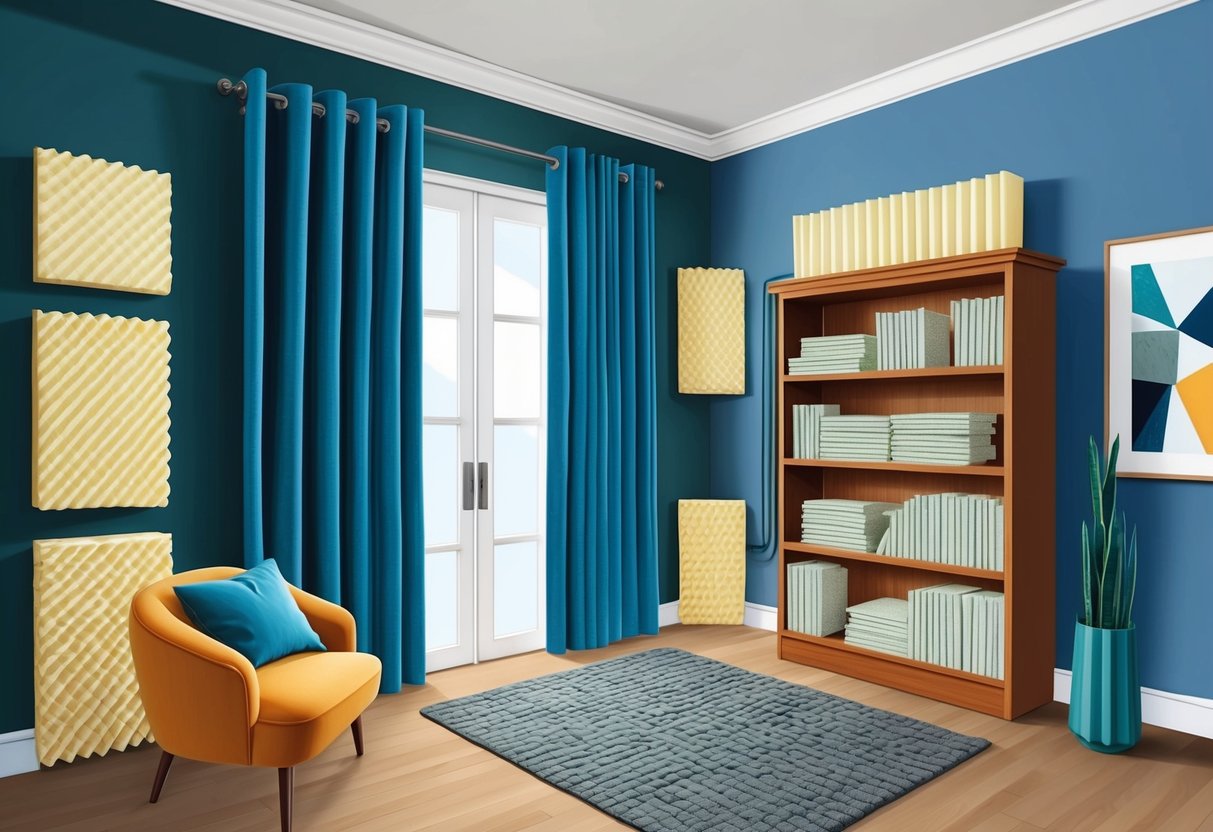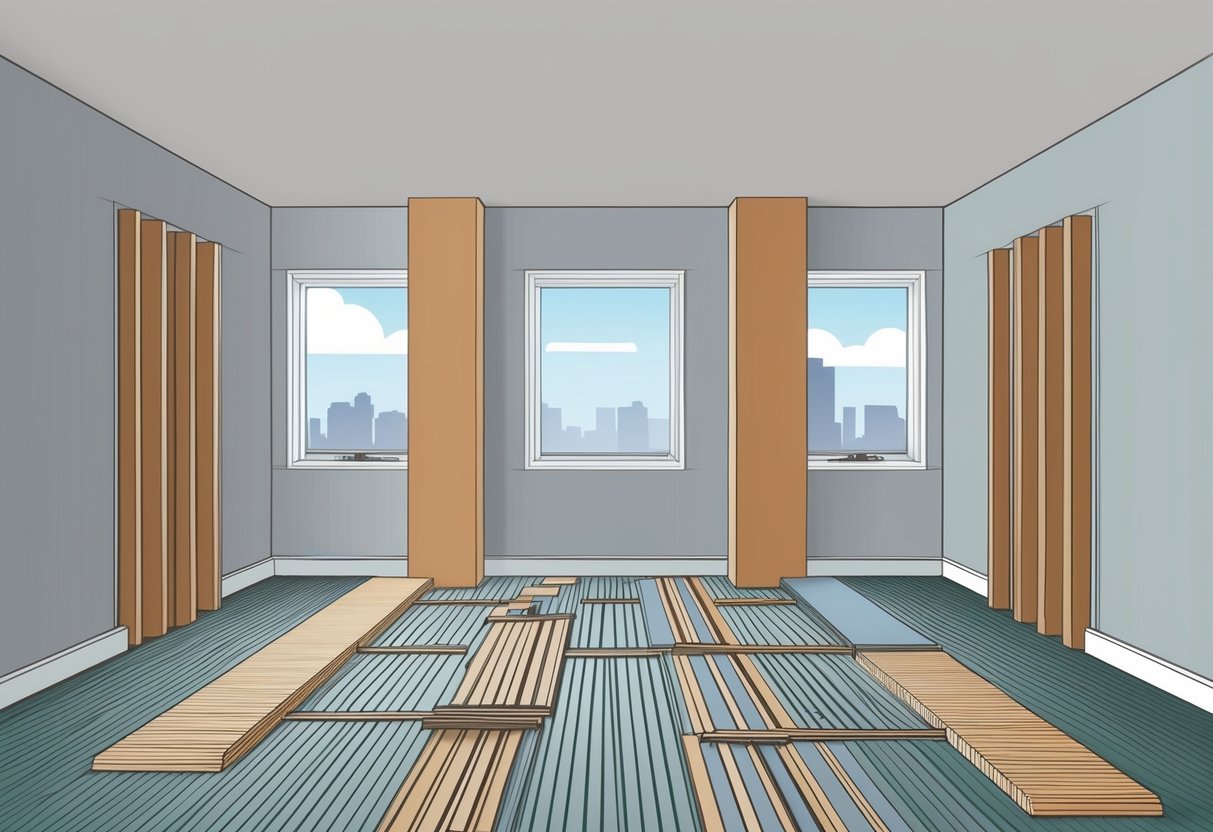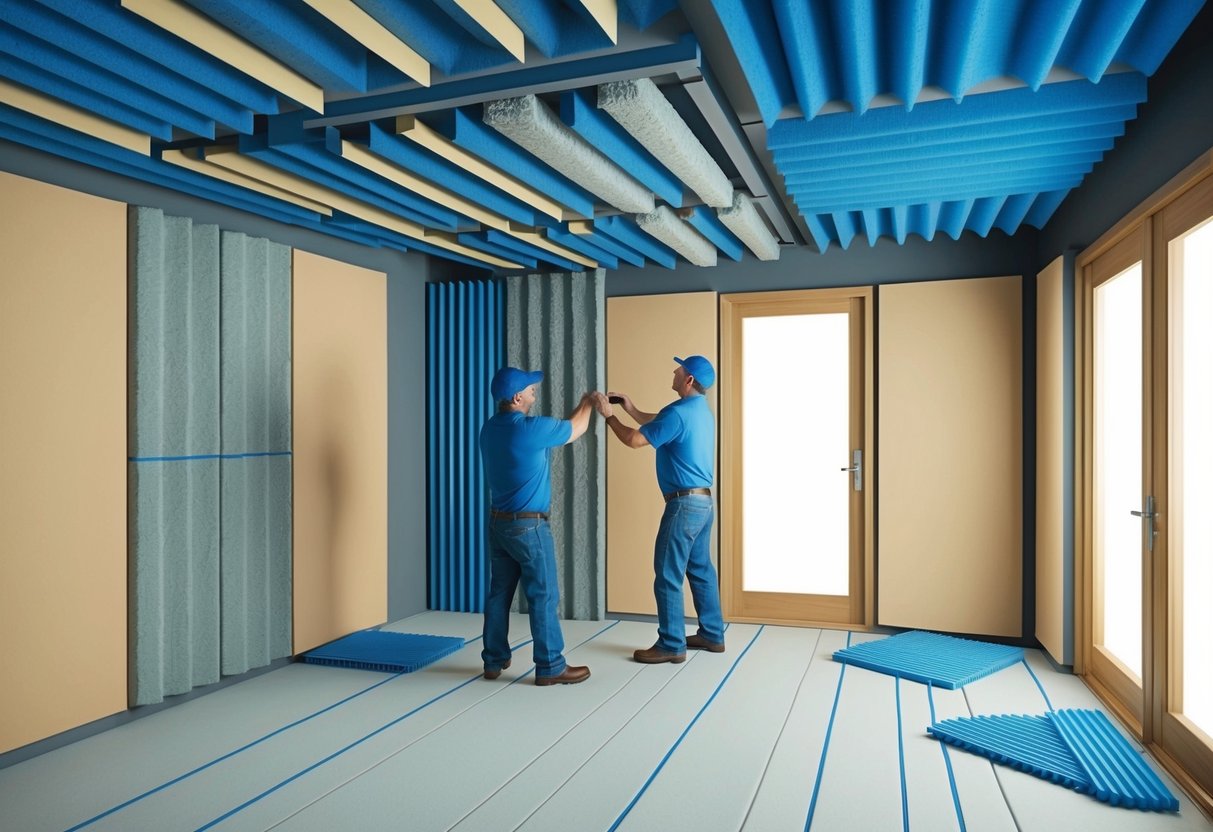
Using Acoustic Foam and Foam Tiles
Acoustic foam and soundproof foam tiles offer an easy-to-install solution for both home studios and common living areas. These materials dampen sound by absorbing mid and high frequencies, which helps reduce reverb and flutter echoes.
Acoustic foam typically comes in a wedge or pyramid shape for increased surface area and absorption. Foam tiles are lightweight and can be mounted on walls, ceilings, or even doors.
For best results, users should cover at least 15-20% of a room’s surface. Acoustic foam is especially effective in corners, where sound tends to build up.
Using a combination of shapes and thicknesses allows for better control over specific frequency problems, providing a tailored acoustic environment.
Controlling Reverberation with Bass Traps and Diffusers
Bass traps are crucial for rooms that struggle with low-frequency buildup, such as home theaters or recording spaces. These typically fit into corners where bass energy accumulates.
Bass traps are denser and thicker than regular panels, specifically designed to absorb deeper sound waves and control reverb. Diffusers, by contrast, scatter sound waves in different directions instead of absorbing them.
This reduces harsh echoes without making a room feel overly “dead.” Placing diffusers on the rear wall or ceiling is common practice in rooms where balanced, natural sound is desired.
Using a strategic mix of bass traps and diffusers helps balance absorption and diffusion, leading to clearer, more accurate sound quality as described in professional guides from Acoustical Surfaces.
Addressing Small Gaps and Flanking Paths

Sound can travel through the tiniest cracks and spaces, making small gaps and flanking paths significant contributors to unwanted noise. Making targeted improvements can greatly reduce how much sound moves between rooms or from outside.
Sealing Electrical Outlets and Openings
Electrical outlets, light switches, and similar wall openings can create weak points for airborne noise transfer. It is practical to install foam gaskets or outlet sealers behind cover plates.
These inexpensive barriers help block both sound and drafts. In newer or particularly noisy areas, consider using putty pads or acoustic backing materials, which mold around outlets or junction boxes to create an acoustic barrier.
Care should be taken to check for gaps between the electrical box and drywall, and fill any spaces thoroughly. For maximum sound reduction, ensure all wall penetrations for cables, ducts, or pipes are sealed and insulated.
A routine inspection will help identify neglected or hidden spots where noise could seep through.
Applying Acoustic Caulk and Sealants
Standard caulks are not ideal for controlling noise because they dry stiff and may crack over time. Use acoustic caulk or acoustical sealant, which stay flexible and form tighter bonds that block sound transmission better.
Focus on gaps around window and door frames, baseboards, floor-wall joints, and any seams where different materials meet. These are classic weak points for sound leaks.
Acoustic caulk is simple to use—cut the tip, apply a bead along the gap, and smooth it with a finger or tool. Clean excess before it dries.
For ongoing projects, keep the sealant on hand to patch new or shifting cracks as the home settles.
Blocking Flanking Sound and Air Gaps
Flanking sound travels along indirect pathways, such as through hidden joints, under flooring, or via ductwork. It is important to identify and block these routes for comprehensive soundproofing.
Use materials like acoustic SoundMats for floors, and consider resilient mounting clips for ceilings to reduce vibration transfer. Where air can pass, such as along baseboards or under doors, use weatherstripping, sweeps, or dense foam tape.
Even small air gaps contribute to noise leaks. Thoroughly inspect corners, window casings, and transitions between drywall and framing.
Use acoustical sealant, dense foam strips, or other gap-fillers to address every potential air channel and create an effective barrier against flanking noise, as highlighted by soundproofing experts.
Selecting Soundproofing Materials and Products

The effectiveness of any soundproofing project depends largely on the right combination of materials and products. Property owners can maximize noise reduction and achieve better results by carefully evaluating insulation, barrier products, and commercially available solutions.
Comparing Insulation Types
Fiberglass batt insulation is a popular option for absorbing airborne sound and reducing transmission through walls, ceilings, and floors. This material is cost-effective, widely available, and easy to install in most wall cavities.
Fiberglass acts by trapping sound waves and reducing their energy before they can penetrate through to the other side of a partition. Mineral wool insulation offers improved density over fiberglass and provides both sound absorption and fire resistance.
Its higher mass and rigidity allow for better control of mid to high-frequency sounds, making it suitable for home theaters or music rooms. Cellulose insulation, often made from recycled paper, can also be dense enough for moderate soundproofing, but is more commonly used for thermal purposes.
When selecting insulation, checking the Sound Transmission Class (STC) rating is essential. Materials with an STC rating of 50 or above are typically considered effective for most residential soundproofing projects.
Choosing Between Mass-Loaded Vinyl and Other Barriers
Mass-loaded vinyl (MLV) is a flexible, dense material that can be added to walls, ceilings, and floors to create a robust sound barrier. It excels at blocking both airborne and impact noise without adding significant thickness to structures.
MLV is easy to install and effective when combined with insulation or drywall in renovation and new construction. Compared to drywall alone, MLV’s higher density blocks a wider range of sound frequencies.
For even greater noise reduction, it can be layered with products like acoustic caulk and resilient channels. However, while MLV is effective, it tends to be more expensive per square foot than standard drywall or gypsum board, so cost is an important factor to consider.
Some homeowners may also look into alternatives such as green glue, which is used as a damping compound between layers of drywall. Green glue helps dissipate vibration and complements barriers like MLV, but does not act as a standalone barrier.
Evaluating Commercial Soundproofing Solutions
Commercial soundproofing products are engineered for ease of installation and high performance. Common options include acoustic panels, decorative wall coverings, door sweeps, and soundproof curtains.
Each product addresses specific noise control challenges in different parts of a home. Acoustic panels are made of porous materials and absorb sound waves, reducing echo and reverberation within a room.
Door sweeps and weatherstripping help seal gaps where sound can leak, especially around doors and windows. Heavy-duty soundproof curtains can reduce exterior noise but are less effective than dense barriers or proper wall treatment.
Property owners can find helpful guides on practical product selection and installation at home improvement retailers such as The Home Depot and specialist manufacturers. When comparing solutions, buyers should look for published STC ratings and choose products appropriate to the type and level of noise they want to control.